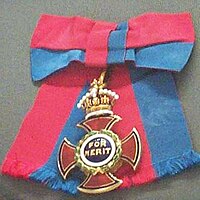
Back Order of Merit Afrikaans نيشان الاستحقاق Arabic "Xidmət" ordeni (Böyük Britaniya) Azerbaijani Ордэн Заслуг (Вялікабрытанія) Byelorussian অর্ডার অফ মেরিট Bengali/Bangla Orde del Mèrit (Regne Unit) Catalan Řád Za zásluhy (Velká Británie) Czech Fortjenstordenen (Commonwealth of Nations) Danish Order of Merit German Order of Merit English
| Order of Merit | |
|---|---|

| |
| Insignia of the Order of Merit presented to Dorothy Hodgkin, displayed in the Royal Society in London | |
| Awarded by the sovereign of the Commonwealth realms | |
| Type | Dynastic order |
| Royal house | House of Windsor |
| Motto | FOR MERIT |
| Eligibility | All living citizens of the Commonwealth realms |
| Awarded for | At the monarch's pleasure |
| Status | Currently awarded |
| Sovereign | Charles III |
| Grades (w/ post-nominals) | Member (OM) |
| Established | 1902 |
| Precedence | |
| Next (higher) | Dependent on state |
| Next (lower) | Dependent on state |
| Ribbon of the Order of Merit | |
The Order of Merit (French: Ordre du Mérite)[n 1] is an award, for notable work in the armed forces, science, art, literature, or for the promotion of culture. The order was set up in 1902, by Edward VII. Membership of the order is a personal gift of its Sovereign (the monarch does not take advice from politicians about who should be a member). The sovereign of the order is the reigning monarch of the Commonwealth realms. The award is limited to 24 living recipients at any one time from these countries, plus a small number of honorary members.[1]
Whilst all members can use the post-nominal letters OM and a medallion for life,[2] the Order of Merit's precedence, amongst other honours, differs between Commonwealth realms.
Cite error: There are <ref group=n> tags on this page, but the references will not show without a {{reflist|group=n}} template (see the help page).
- ↑ The Royal Household. "The Queen and the UK > Queen and Honours > Order of Merit". Queen's Printer. Archived from the original on 18 July 2009. Retrieved 28 July 2009.
- ↑ Jackson, Michael D. (2007). "The Order of Merit 1902-2002: One Hundred Years of Matchless Honour" (PDF). Canadian Monarchist News. Toronto: Monarchist League of Canada. p. 15. Archived from the original (PDF) on 25 June 2008. Retrieved 28 July 2009.